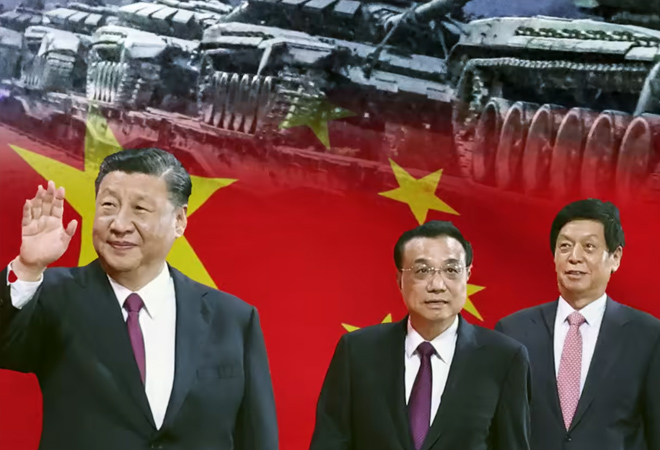-
CENTRES
Progammes & Centres
Location
Learning from the lapses made by Russia, the PLA may strike a swift blow to the Taiwanese national resolve in the event of an invasion

As the Ukraine conflict enters its second year, the last 12 months have provided the Communist Party of China (CPC) a great opportunity to closely examine how modern wars are waged and its implications with regard to Taiwan. The conflict’s volatility and the impact it can have on Russian President Vladimir Putin’s regime must be weighing on the CPC’s mind, particularly the challenge of winning quickly and decisively in the event of its invasion of Taiwan.
Lessons from another war
A divergence in the CPC’s perception of itself has had a major bearing on its formulations of national security. While China may be perceived as a powerful country globally, the CPC thinks of itself as a fragile entity under siege by enemies. This is supplemented by the notion that the seeds of the Imperial Qing dynasty’s downfall lay in its incapacity to modernise its defence, which consequently emboldened other powers to browbeat it.
The conflict’s volatility and the impact it can have on Russian President Vladimir Putin’s regime must be weighing on the CPC’s mind, particularly the challenge of winning quickly and decisively in the event of its invasion of Taiwan.
China’s power structure complicates matters. While armies serve the state, China’s People’s Liberation Army (PLA) serves the CPC. Modern China’s founder, Mao Zedong, had propounded that “power flows from the barrel of a gun”, meaning that the PLA was an important pillar of state power and that its primary function was to prop up the Party. Hence, when the CPC’s hold on power was challenged during the 1989 Tiananmen Incident, the PLA was brought in to quell the uprising and bolster the Party’s rule. Thus, the PLA’s mission was to help the CCP consolidate power and to maintain domestic security.
Additionally, since the PLA has largely been untested in battle in recent years, it necessitates the CPC to actively study conflicts and draw lessons. Therefore, the CPC did an assessment of the 1991 war against Saddam Hussain where the US-led coalition used hard power in a bid to dislodge Hussain from power. China reached the conclusion that, in front of America’s brazen show of technological prowess like precision bombing, stealth bombers, and missile interception, the PLA needed to be transformed into a modern force. Since Chinese economic reforms had taken off by the late 1990s, which translated into double-digit economic growth, it meant that the nation could commit more resources to the PLA. Thus, by 2019, China’s defence outlay was US $176 billion, next only to America’s US $732 billion. Mao-era doctrines like “People’s War” were abandoned in favour of building “modern regional warfare capabilities under high-tech conditions”.
Striking at national spirit
Both Ukraine and Taiwan are the modern-day Davids threatened by the more powerful Goliaths. But what has sustained the resolve of these nations is the national spirit and crystallisation of national identity. Sometimes, the fundamental premise of war is forged in myth, not calculated battle strategies. Putin initially thought that “fraternal Slavic bonds” would ensure a swift victory for the Russian forces, but his aggression kindled Ukrainians’ national resolve. This has kept the morale of Ukrainian citizenry high despite Russia’s severe onslaught. One lesson that the PLA may draw from this is that it will have to strike a swift blow to the Taiwanese national resolve, and it seems to be working on it via ‘influence operations’. For example, Canadian intelligence recently reported that Chinese diplomats perceived Canada’s Conservative Party as working against its interests and thus actively worked to rout political aspirants from that party who were considered to be unfriendly to Beijing, in the 2021 federal elections.
The Taiwanese presidential election is due in 2024 and Beijing is increasingly building bridges with the opposition Kuomintang (KMT) party, which emerged victorious in local polls in 2022. Recently, KMT Vice Chairperson, Andrew Hsia, visited China and met with CPC officials in charge of the Taiwan portfolio, catching flak from the ruling Democratic Progressive Party. Thus, the one-party mainland seems keen to exploit political schisms in democratic Taiwan. At the same time, it is clandestinely making inroads into Taiwan’s establishment as is evidenced by the latest revelations of a spy ring operating in the defence forces and the active recruitment of personnel in passing on sensitive information to Beijing.
It begs the question as to whether it was a clarion call to elements sympathetic to the CPC in Taiwan in a bid to sow confusion and sap national resolve to confront CPC’s designs.
In his New Year address to the nation, President Xi Jinping said, “The people on both sides of the Taiwan Strait are members of one family” and that he hoped that “compatriots in Taiwan would work together with a unity of purpose” for the Chinese nation. It begs the question as to whether it was a clarion call to elements sympathetic to the CPC in Taiwan in a bid to sow confusion and sap national resolve to confront CPC’s designs. Influence operations go hand-in-hand with psychological operations (Psyops) in order to chip away at the national resolve. Last year, an audio recording of a secret meeting where PLA commanders were discussing plans to invade Taiwan and how to mobilise for it was leaked. Many saw this as a psy-op tactic to whittle down Taiwan.
Besides, the CPC has doubled down on these measures in the last few years as evidenced from increasing cyberattacks in Taiwan, and an onslaught against physical cyber infrastructure. Recently, underwater cables that connected Taiwan’s Matsu Island to the internet were ruptured, affecting its internet connectivity. Some believe this may be Beijing preparing ground for severing Taiwan’s access to the internet in the eventuality of an invasion.
Stoking nationalism for mobilisation
Since the Europe battlefield has proved that national resolve is more important than military hardware, the PLA will try its best to wear out Taiwan.
While China has been trying to sap the morale of Taiwanese citizens, it faces the onerous task of mobilising its people in the event of it invading the island. Now, in light of the spy balloon row between China and the US, it is becoming clear that the former has begun to rely heavily on grey zone warfare, in which a state escalates just below the threshold of conflict. Taiwan has been bearing the brunt of this for some time, given the PLA’s military aircraft’s regular aerial incursions into Taiwanese airspace. Given the opprobrium Russia has courted for the invasion, China will bank on Taiwan making a misstep to create a perception that Taiwan “fired the first shot”. For instance, the collision in 2001 between an American spy craft flying over the South China Sea and a Chinese fighter craft was used by the CPC to whip up Chinese nationalism against America.
Thus, the PLA has used previous conflicts to update its battle tactics and the European theatre is the latest in this series for the Chinese to study modern warfare, particularly in the context of any adventure in the Taiwan Strait. The Ukraine conflict is particularly important to the PLA since the Chinese defence forces and Russian militaries have a common Soviet gene. Since the Europe battlefield has proved that national resolve is more important than military hardware, the PLA will try its best to wear out Taiwan.
The views expressed above belong to the author(s). ORF research and analyses now available on Telegram! Click here to access our curated content — blogs, longforms and interviews.

Kalpit A Mankikar is a Fellow with Strategic Studies programme and is based out of ORFs Delhi centre. His research focusses on China specifically looking ...
Read More +